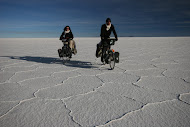We have crossed the Argentine Tierra Del Fuego for a week now. From Ushuaia, we first crossed the Cordillera Darwin, which offered us fantastic montain landscapes. Then, nothing else than flat plains covered by dry yellow grass, constantly blowed by ferocious winds. Those winds significantly affected our daily mileages. In the plains, a few outcrops provided us with basic geological informations: horizontal shaly and sandy sediments with a very few structures. We were in the Magellan Basin, partly onshore and mainly offshore. In the middle of the low lands, we found hospitality in estancias where people offered us food, based on "cordero patagonico" (patagonian lamb) and a place to sleep.
But this day, we had a geological destination: the oil and gas plant of Rio Cullen, operated by Total Austral. The access was quite challenging: 80 km of gravel road, partly with unfavorable wind. From the border station of San Sebastian, an amazing landscape was offered to us: a large laguna lied over ten of kilometers. Similarly to the Mont St Michel Bay in France, the high tide regularly filled and emptied the bay. In the horizon, groups of guanacos ran in the mud of the bay between small bushes. We crossed this peculiar flat scenery that we even did not distinguish the boundary.

Suddenly, some spots appeared in the horizon: they were the first oil wells we observed during the trip. Those wells were the only traces of human activity in this remote area. At the end of the day, we started to be seriously tired. There were 10 km left with side wind. Finally, the plant appeared at the end of the road. There were still some kilometers left but this view was really encouraging for us. We were riding with this new motivation when I figured out that my back tire was flat. Caroline went ahead to announce our arrival while I repaired the pucture. Half an hour later, I was back on my saddle. It was 9.30 pm and the sun was really low. The clouds above the plant were red as if the plant made them burn. Despite this late arrival, we were very welcomed and a good diner and a repairing night were offered to us.

The following day, we first had an interview with the chief of the plant: Philippe Falguere. Although he had a heavy timetable, he spent some time to describe and explain the whole plant. Suddenly, he called the superintendant of the plant and ordered him to prepare our visit and two extra flight gears. He explained us that today was the helicopter flight over the infrastructures to check if there was no leak, and we will be in the flight!
Then he described us the plant: it employs 300 people, 95% being argentines. The personnel is doubled because the work is organised in rotations of 28 working days/28 resting days. Most of the employees do not leave in Tierra Del Fuego, and this schedule allows them to spend time with their family. The plant gathers all the steps from extraction of hydrocarbons to chemical treatment and purification. Offshore and onshore, the plant is connected to tens of wells that produce gas and oil. Offshore, four platforms control and manage those wells and send their products to the plant. The wells are several km deep, and some of them are horizontal. Philippe explained that one of them reached a reservoir at more than 11 km away from the platform: it was the world record when it was perforated.

After a good lunch and a good coffee, we prepared for the helicopter flight. We weared unconfortable gears and got into the helicopter. It was the first helicopter flight for Caroline and my second one, and we felt a bit nervous, especially because the wind blowed very strongly. We first flied over the Rio Cullen Plant before going offshore, over the platforms. Behind us, the long cliffs of yellow sandstones stretched along the shore out of sight, whereas we reached the first platform. Personnel work 24 hours a day to maintain the production. A special boat, built in Bergen, made the shuttle between the platforms all the time. Some sea wolves, cousins of sea lions, jumped from the buoy in the ocean when the helicopter approached.




Finally we ended the day with a traditionnal argentine asado (barbecue). We were very surprised to see that alcohol was allowed in the plant. Philippe explained us that he was sceptical when he arrived here one and half year ago. But he is now more relax because argentines self-regulated their behaviour at work, and he never had any problem. The atmosphere was very good and the life very confortable. Everything is done to make life easier in this plant of the end of the world.


